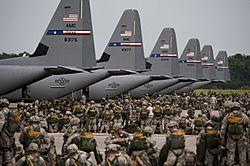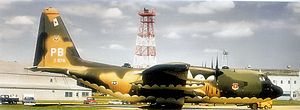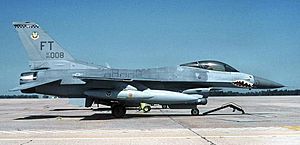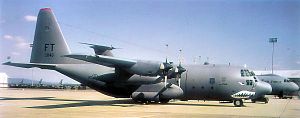Pope Field facts for kids
Pope Field is a United States military base in North Carolina. It is about 12 miles (19 km) northwest of Fayetteville. This important facility used to be called Pope Air Force Base. Now, the U.S. Air Force works with the U.S. Army to run it. Pope Field is part of Fort Liberty, a large Army base.
Quick facts for kids Pope Field |
|||||||||
|---|---|---|---|---|---|---|---|---|---|
| Pope Army Airfield | |||||||||
| Part of Fort Liberty | |||||||||
| Near Fayetteville, North Carolina in the United States of America | |||||||||

Soldiers from the US Army 82nd Airborne Division prepare for a mass parachute jump from US Air Force C-130J Hercules during an exercise at Pope Field in 2013.
|
|||||||||
 |
|||||||||
| Coordinates | 35°10′15″N 79°00′52″W / 35.17083°N 79.01444°W | ||||||||
| Type | US Army Air Field | ||||||||
| Site information | |||||||||
| Owner | Department of Defense | ||||||||
| Operator | US Army / US Air Force | ||||||||
| Controlled by | US Army / Air Mobility Command | ||||||||
| Condition | Operational | ||||||||
| Site history | |||||||||
| Built | 1919 | ||||||||
| In use | 1919 – present | ||||||||
| Events | Green Ramp disaster (1994) | ||||||||
| Garrison information | |||||||||
| Garrison | 43rd Air Mobility Operations Group (USAF) | ||||||||
| Airfield information | |||||||||
| Identifiers | IATA: POB, ICAO: KPOB, FAA LID: POB, WMO: 723030 | ||||||||
| Elevation | 66.4 metres (218 ft) AMSL | ||||||||
|
|||||||||
Pope Field (IATA: POB, ICAO: KPOB, FAA LID: POB) is a U.S. military facility located 12 miles (19 km) northwest of the central business district of Fayetteville, in Spring Lake, Cumberland County, North Carolina, United States. Formerly known as Pope Air Force Base, the facility is now operated by the U.S. Air Force via a memorandum of agreement (MOA) and an interservices support agreement (ISSA) with the U.S. Army as part of Fort Liberty.
Contents
History of Pope Field
Early Days
In 1918, the U.S. Congress created Camp Bragg. This was an Army base for artillery, named after a Confederate General. An area for planes to land was added a year later. In 1919, the War Department officially named it "Pope Field." This makes it one of the oldest Air Force bases.
Pope Field is named after First Lieutenant Harley Halbert Pope. He died in a plane crash in 1919. After five years, Camp Bragg became a permanent Army post. It was renamed Fort Bragg, and is now known as Fort Liberty.
In its early years, Pope Field helped with mapping land. It also carried mail and helped spot artillery and forest fires. Observation planes and balloons were used here for the first eight years. In 1927, Pope Field helped develop important flying tactics. These tactics later helped shorten World War II.
Growing Bigger
The 1930s brought the first big expansion to Pope Field. In 1935, 535 aircraft landed there in one day. The United States Army Air Corps practiced large-scale flights along the East Coast. In 1940, paved runways were built instead of dirt fields.
Activities at Pope Field increased quickly when World War II started. During the 1940s, the base grew as a training site for troop carriers. With paratrooper training at Fort Bragg, Pope Field became key for "Airborne" operations. Air and ground crews trained here with Army airborne units. They prepared for missions to drop troops and supplies from the air.
Pope Field became Pope Air Force Base in 1947. It changed back to Pope Field in 2011.
Some old buildings, like Hangars 4 and 5, are now on the National Register of Historic Places. This means they are important historical sites.
Changes Over the Years
After World War II, Pope Field became Pope Air Force Base in 1947. This was when the United States Air Force was created. The base was home to the 10th Tactical Reconnaissance Group. They flew planes like the P/F-51 Mustang for photo missions.
Later, the 4415th Air Base Group took over. Their main job was to train air controllers for the Korean War. The headquarters for the Ninth Air Force was also at Pope from 1950 to 1954.
In 1954, the 464th Troop Carrier Wing moved to Pope. This unit helped move troops and cargo. They also took part in joint training with Army forces. The wing flew humanitarian missions and helped with medical airlifts. They often had squadrons deployed overseas.
The 464th Wing won an award for rescuing hostages in the Congo in 1964. They also helped deploy troops to the Dominican Republic. During their time at Pope, the base grew a lot. Runways and taxiways were expanded. Newer planes like the C-123 Provider and C-130 Hercules arrived.
In 1971, the 317th Tactical Airlift Wing moved to Pope Air Force Base. This wing flew C-130E aircraft. The training at Pope helped aircrews prepare for combat in Southeast Asia. The wing was one of the first to use special equipment for air drops in bad weather.
During the Vietnam War, Pope was a place where fallen service members were brought. After identification, they were sent to their homes or military cemeteries.
In 1992, the 317th Wing became part of the new 23rd Wing at Pope.
The 23rd Wing
After the Gulf War, the military decided to change how air forces were organized. Pope Air Force Base became part of the new Air Combat Command in 1992. The 23rd Wing, which included fighter jets, moved to Pope.
The 23rd Wing had different types of aircraft. These included A/OA-10 Thunderbolt IIs and F-16C/Ds. These planes were used for various missions.
In 1992, C-130s from Pope helped deliver food and supplies to Somalia. They also helped after Hurricane Andrew in Florida. They even dropped relief supplies into Bosnia-Herzegovina.
On March 23, 1994, there was a serious accident at the base. An F-16 and a C-130 collided. The F-16 crashed into a parking area. This accident, known as the Green Ramp disaster, sadly caused many injuries and deaths among Army paratroopers.
In 1994, the 23rd Wing helped evacuate U.S. personnel from Yemen. They also prepared for a large combat troop drop in Haiti. This mission was called off at the last minute.
The 23rd Wing also deployed to the Persian Gulf in 1994. This was during Operation VIGILANT WARRIOR. They were the first U.S. fixed-wing aircraft to be based in Kuwait since the Gulf War.
Later Changes
In 1997, the 23rd Wing was reorganized. The C-130s and Pope Air Force Base became part of Air Mobility Command under the 43d Airlift Wing. This wing helped the Army's XVIII Airborne Corps and 82nd Airborne Division.
The Air Force Reserve Command's 440th Airlift Wing moved to Pope in 2006. They completed their move by 2007. The 440th Wing had C-130H aircraft. They supported missions worldwide and trained with the Army. The 440th Airlift Wing was later closed down in 2016.
Merging with Fort Bragg
In 2005, the Department of Defense decided to change Pope Air Force Base. The plan was to move the A-10 aircraft to Moody Air Force Base in Georgia. The C-130s were to move to Little Rock Air Force Base in Arkansas. The base would also get a Medical Squadron.
On March 1, 2011, Pope Air Force Base officially became part of Fort Bragg. It was renamed Pope Field.
Runway Improvements
By 2019, the runway and lighting system at Pope Field were very old. They needed to be replaced. From 2019 to 2021, a big plan was made to rebuild them. The runway closed in June 2021 for construction. The project finished early, in October 2021. A large C-17 Globemaster III plane was the first to land on the new runway.
What Pope Field Does Today
The United States Army Fort Liberty Garrison manages Pope Field. They provide support for the airfield. This includes security, emergency medical help, and fire response. They also help with aircraft security and maintenance. The garrison supports Air Force units based there.
The United States Air Force 43d Air Mobility Operations Group (AMOG) is also at Pope Field. This group helps with mission control and aircraft maintenance. They also coordinate and support joint training exercises. These exercises are for the Army's XVIII Airborne Corps and 82nd Airborne Division. The 43 AMOG is key for quickly deploying the 82nd Airborne Division's Immediate Response Force.
Other Air Force units also operate from Pope Field. These include the 18th Air Support Operations Group and various Special Operations Squadrons. The Air Force Combat Control School is also located here.
Units Based at Pope Field
Here are some of the important flying and non-flying units at Pope Field. Some units are "Geographically Separate Units" (GSU). This means they are at Pope but report to a parent unit somewhere else.
United States Air Force
|
Air Mobility Command
Air Combat Command
|
Air Force Special Operations Command
|
Education
Children of military families living on base go to schools run by the Department of Defense Education Activity (DoDEA). Albritton Middle School used to take students from Pope Field.
High school students go to public schools in the county where they live. For Pope AFB, this would be Cumberland County Schools.
See also
 In Spanish: Base de la Fuerza Aérea Pope para niños
In Spanish: Base de la Fuerza Aérea Pope para niños








